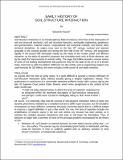Early history of soil–structure interaction
Author(s)
Kausel, Eduardo A.
DownloadSSI Early History.pdf (263.3Kb)
PUBLISHER_CC
Publisher with Creative Commons License
Creative Commons Attribution
Terms of use
Metadata
Show full item recordAbstract
Soil–structure interaction is an interdisciplinary field of endeavor which lies at the intersection of soil and structural mechanics, soil and structural dynamics, earthquake engineering, geophysics and geomechanics, material science, computational and numerical methods, and diverse other technical disciplines. Its origins trace back to the late 19th century, evolved and matured gradually in the ensuing decades and during the first half of the 20th century, and progressed rapidly in the second half stimulated mainly by the needs of the nuclear power and offshore industries, by the debut of powerful computers and simulation tools such as finite elements, and by the needs for improvements in seismic safety. The pages that follow provide a concise review of some of the leading developments that paved the way for the state of the art as it is known today. Inasmuch as static foundation stiffnesses are also widely used in engineering analyses and code formulas for SSI effects, this work includes a brief survey of such static solutions.
Date issued
2010-01Department
Massachusetts Institute of Technology. Department of Civil and Environmental EngineeringJournal
Soil Dynamics and Earthquake Engineering
Publisher
Elsevier
Citation
Kausel, Eduardo. “Early History of Soil–structure Interaction.” Soil Dynamics and Earthquake Engineering 30, no. 9 (September 2010): 822–832. © 2009 Elsevier Ltd.
Version: Author's final manuscript
ISSN
02677261